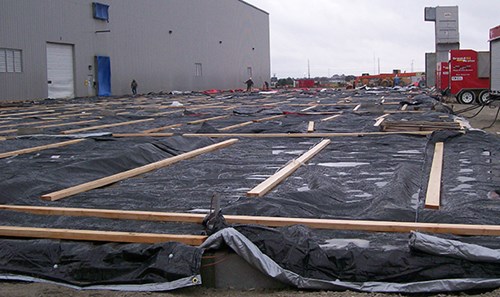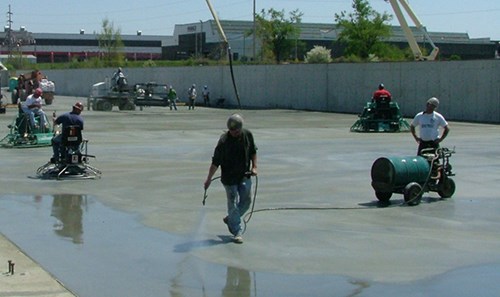Part 2: How Do We Cure Concrete?
As we learned in Part 1 of this series, properly curing new concrete plays an important role in its strength development and long-term durability. Curing must take place immediately after concrete placing and finishing, and involves maintaining both the moisture content and temperature of the concrete for a period of defined by industry standards or the project specification. Well-cured concrete has good strength development, volume stability, resistance to freezing and thawing, abrasion, and scaling.
There are several methods for curing freshly placed concrete, but not all of these methods are equal in price, availability, or effectiveness. The curing method used will depend on many factors, such as the economics of the project, the availability of water or other curing materials, labor constraints, control of water runoff when wet curing is used, expected weather conditions during the curing period, and future requirements such as the floor finish or application of coverings or coatings. In general, there are two high-level methods of curing new concrete:
- Retention of mix water by maintaining high humidity at the concrete surface with ponded water, fogging, or water-saturated coverings
- Application of a physical barrier such as plastic sheeting or a liquid membrane-forming curing compound or cure & seal
To describe how we cure concrete with these methods, we must explore what is meant by initial and final curing.
Initial Curing
Initial curing refers to activities implemented anytime between concrete placement and finishing to reduce the loss of moisture from the concrete surface during that time. Fogging, or fog spraying, is an initial curing method that provides excellent protection against surface drying, but can only be used when the air temperature is well above freezing. Fogging humidifies the air directly above the concrete and replaces bleed water, which buys time for placing, strike-off, and bull-floating operations, all the way until the start of floating or brooming. Fogging is also useful for reducing the tendency for a crust to form on the surface of freshly placed concrete.
Liquid-applied evaporation retarders have been used as an initial curing method for decades. Evaporation retarders are water-based solutions of organic chemicals that form a very thin film over the bleed water layer. This film reduces the rate of evaporation of the bleed water from the concrete surface. Once the finishing starts, care must be taken not to work bleed water, fogging water, or evaporation retarder into the slab, or you risk creating a porous and weak concrete surface.
Final Curing
Final curing procedures are implemented after final finishing and when the concrete has reached final set. Final curing based on application of water include sprinkling and ponding of water on the surface. Intermittent sprinkling should not be used if the concrete surface is allowed to dry between periods of wetting, as this causes stress to the new concrete and can do more damage than good to the slab. For water-application curing methods to be viable and effective, the air temperature must be above freezing, water must be in ample supply and not cost-prohibitive and potential contamination of run-off to surrounding soils and streams must be considered.

Final curing materials like burlap and cotton mats work by absorbing and holding water on horizontal or vertical concrete surfaces. Some have an integral vapor barrier to help prevent drying out of the absorbent material to provide sufficient long-term curing moisture to the concrete. Similarly, rolls of reusable sheet curing materials are typically composed of less-absorbent yet very durable synthetic fabrics that have a fairly long life span and when properly used and cared for to prevent damage and contamination. Sheet curing materials must lay flat on the new concrete to decrease the chance of shifting due to wind and slab discoloration from wrinkles and entrapped air. Plastic film used for curing concrete should meet the requirements of ASTM C171.
Liquid membrane-forming compounds for final curing of concrete should comply with the requirements of ASTM C309 (curing compounds) or C1315 (cure & seals) when tested at the rate of coverage to be used on the job. Curing compounds that meet the requirements of ASTM C309 help new concrete retain moisture and control temperature if it is formulated to contain a reflective, white pigment. Cure & seals that meet the requirements of ASTM C1315 are more efficient at preventing moisture loss than curing compounds, and have special properties such as alkali resistance, acid resistance, adhesion-promoting qualities, and resistance to degradation by ultraviolet light. Table 1 compares the general requirements of ASTM C309 and C1315.
 For maximum benefit, liquid membrane-forming curing compounds and cure & seals should be applied immediately after the disappearance of the surface water sheen following final finishing. Delayed application of these materials not only allows drying of the surface during the period of peak water loss, but also increases the likelihood that the compound will be absorbed into the concrete and not form a membrane on the surface as it is intended.
For maximum benefit, liquid membrane-forming curing compounds and cure & seals should be applied immediately after the disappearance of the surface water sheen following final finishing. Delayed application of these materials not only allows drying of the surface during the period of peak water loss, but also increases the likelihood that the compound will be absorbed into the concrete and not form a membrane on the surface as it is intended.
The required duration of curing method to be in place is a complicated discussion, as it depends on the composition and proportions of the concrete mixture, the values to be achieved for desired concrete properties, the rate at which desired properties are developing while curing measures are in place, and the rates at which those properties will develop after curing measures are terminated.
American Concrete Institute (ACI) Committee 301 recommends a minimum curing period corresponding to concrete attaining 70 percent of the specified compressive strength1. The 70 percent strength level can be reached sooner when concrete cures at higher temperatures or when certain cement/admixture combinations are used. Similarly, longer time may be needed for different material combinations and/or lower curing temperatures. For this reason, ACI Committee 308 recommends the following minimum curing periods based on cement type2:
- ASTM C150 Type I cement: 7 days
- ASTM C150 Type II cement: 10 days
- ASTM C150 Type III cement: 3 days
- ASTM C150 Type IV or V cement: 14 days
- ASTM C595, C845, C1157 cements: variable
In Part 3 of the Demystifying Concrete Curing & Sealing Series, we’ll take an exciting look at some of the more nonconventional methods of curing: internal curing with lightweight aggregate, and the use of reactive silicate solutions on fresh concrete.
References:
- ACI 301-16 Specifications for Structural Concrete
- 308R-16 Guide to External Curing of Concrete
Jennifer Crisman is the Director of Marketing Services at Euclid Chemical. She can be reached at jcrisman@euclidchemical.com.